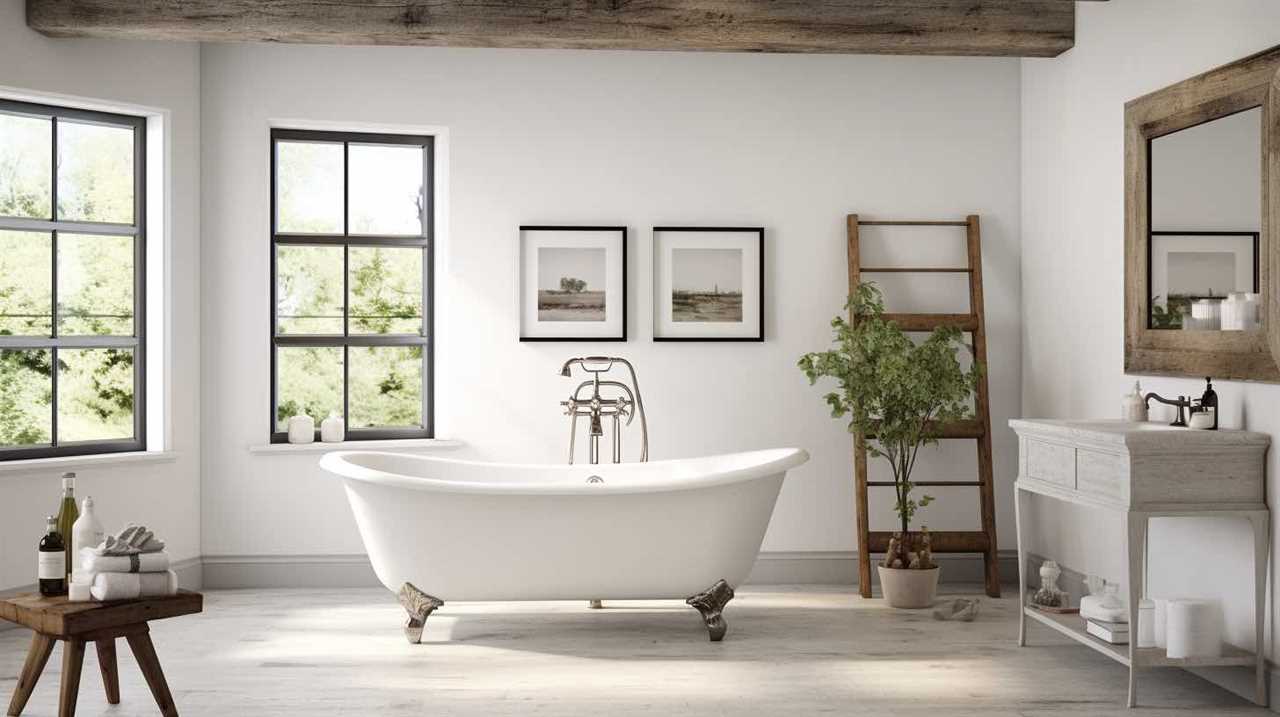Looking to give your toilet a fresh look? Look no further! Painting a toilet is a simple and cost-effective way to transform its appearance. Whether you prefer the durability and weather resistance of epoxy paint or the versatility of spray paint, this article has got you covered.
From preparing the toilet for painting to thoroughly cleaning and emptying it, this step-by-step guide will walk you through the process.
Get ready to revamp your toilet and enjoy a brand new look!
Key Takeaways
- Epoxy paint and spray paint are two types of paint commonly used for painting toilets.
- Epoxy paint provides better adhesion, protection against corrosion, and superior moisture barriers.
- Spray paint offers more control over colors and patterning and comes in a wide range of colors.
- Both types of paint require proper preparation of the toilet, such as cleaning, sanding, and applying primer, before painting.
Types of Paint for Toilet
Epoxy paint and spray paint are the two types of paint commonly used for painting toilets.
Epoxy paint is a water-based, durable, and weather-resistant coating that provides better adhesion and protection against corrosion. It also offers a superior moisture barrier, making it a popular choice for toilet painting. It comes in three basic colors: white, grey, and black, giving toilets a shiny and bright appearance.
On the other hand, spray paint is an aerosol paint that comes in an air-pressurized can, allowing for more control over colors and patterning. It can be used to paint both the inside and outside of the toilet bowl and comes in dozens of colors.
One common mistake to avoid when painting a toilet is not applying an extra layer of epoxy coating for moisture protection. This is crucial to prevent peeling and chipping of the paint. Another mistake is not properly cleaning and preparing the toilet before painting, which can result in poor adhesion and a less durable finish.
Tools Needed to Paint the Toilet
The tools needed for the task include skin and eye protection gear, pliers, cleaning tools, fine sandpaper, and waterproof painters tape.
When it comes to toilet painting techniques, it is important to have the right tools on hand. Skin and eye protection gear, such as masks, goggles, and gloves, will ensure safety during the process. Pliers will be necessary for removing the toilet seat if it needs to be painted as well. Cleaning tools, such as rags and cleaning products, will help in preparing the surface for painting. Fine sandpaper with 180 grit will be used to create a rough surface for better paint adhesion. Waterproof painters tape will be essential for protecting areas that should not be painted.
Steps to Prepare the Toilet for Painting
To prepare the toilet for a new coat of paint, one should start by thoroughly cleaning the bowl with a toilet cleaner. This step ensures that any dirt, grime, or residue is removed, providing a clean surface for the paint to adhere to.
After cleaning, it is important to choose the right color scheme for the toilet. This decision can be based on personal preference or the overall aesthetic of the bathroom. Some popular choices include neutral colors like white, gray, or black, which give the toilet a clean and modern look.
Once the color scheme is chosen, the painting technique can be determined. Whether using epoxy paint or spray paint, following the proper steps and applying multiple coats will result in a fresh and vibrant finish.
Steps to Clean the Toilet Thoroughly
After applying the appropriate cleaner, they should polish the toilet bowl to ensure it is thoroughly cleaned and ready for painting. To effectively remove stains from a toilet bowl and maintain a clean toilet, here are some tips:
- Use a toilet cleaner and a toilet brush to polish the bowl, focusing on any dark stains.
- Wear rubber gloves for protection while cleaning.
- Rinse the toilet bowl to remove any residue.
- If there are rust or mineral deposits, use a toilet bowl cleaner specifically designed to remove them.
By following these tips, one can ensure a sparkling clean toilet bowl, free from stains and dirt.
Regular maintenance and cleaning will help maintain a hygienic and fresh bathroom environment.
Steps to Empty the Toilet
To effectively empty the toilet, one should follow these steps:
-
Close the shutoff valve: This is an essential step in controlling the water flow and preventing any water from entering the toilet tank.
-
Flush the toilet: Once the valve is closed, flushing the toilet will initiate the process of emptying the bowl and tank. This will remove any waste and water from the toilet system.
-
Manually lift the tank float: To ensure that the tank does not refill, it is important to manually lift the tank float. This action prevents the float from activating the refill mechanism, keeping the toilet empty until it is ready to be refilled again.
FAQs and Additional Information
When selecting a color to repaint the inside of a toilet bowl, one should be cautious and considerate of their personal preferences. Choosing the right paint color for a toilet can have a significant impact on the overall look and feel of the bathroom.
Here are some tips for protecting the toilet while painting:
- Use waterproof painters tape to cover the areas you don’t want to paint, such as the hinges and the toilet seat.
- Place a drop cloth or old towels around the toilet to catch any drips or spills.
- Wear skin and eye protection gear, such as masks, goggles, and gloves, to protect yourself from the paint fumes and potential splatters.
- Make sure to thoroughly clean and dry the toilet bowl before applying the paint to ensure proper adhesion and a smooth finish.
Feedback and Comments
Users can provide feedback and comments on the post to rate its usefulness and suggest improvements.
When it comes to choosing the right paint for your toilet, there are a few factors to consider. First, decide whether you want to use epoxy paint or spray paint. Epoxy paint is a water-based, durable, and weather-resistant coating that provides better adhesion and protection against corrosion. It also offers superior moisture barriers and comes in basic colors like white, grey, and black.
On the other hand, spray paint gives you more control over colors and patterning, but it requires an extra layer of epoxy coating for moisture protection.
If you’re looking to paint a toilet seat, make sure to choose an appropriate appliance epoxy spray paint. Most plastic seats are white, like the porcelain bowl, so select a color that matches or complements your bathroom decor. After painting, the seat will look brand new.
Overall, when it comes to painting your toilet, always wear appropriate protective gear and follow the necessary steps to prepare the surface, apply the primer, and paint the toilet. Taking these precautions will ensure a fresh and long-lasting look for your toilet.
Conclusion
After receiving feedback and comments from readers, it is time to conclude the topic of painting a toilet. Painting a toilet can give it a fresh and updated look, but it also comes with its own set of pros and cons.
Here are some of the pros of painting a toilet:
- Gives the toilet a new and refreshed appearance
- Allows for customization and personalization
- Provides a protective layer against corrosion and moisture
- Can be a fun and creative DIY project
On the other hand, there are also cons to consider:
- Requires proper preparation and cleaning before painting
- May require multiple coats and touch-ups
- Can be time-consuming and labor-intensive
- Paint may not adhere well to certain surfaces
When choosing the right paint for your toilet, consider the following tips:
- Use epoxy paint for better adhesion and protection
- Opt for water-based, durable, and weather-resistant coatings
- Select colors that complement your bathroom decor
- Consider using spray paint for more control and patterning
Frequently Asked Questions
Can I Use Regular Wall Paint to Paint a Toilet?
Yes, regular wall paint is not recommended for painting a toilet. It is best to use epoxy paint or spray paint specifically designed for toilets. These types of paint provide better adhesion, moisture protection, and durability.
What Is the Drying Time for Epoxy Paint on a Toilet?
The drying time for epoxy paint on a toilet can vary depending on factors like temperature and humidity. Typically, it takes around 24 hours for epoxy paint to fully dry and cure.
Do I Need to Remove the Toilet Seat Before Painting the Toilet?
Yes, the toilet seat should be removed before painting the toilet. This ensures that the seat is not accidentally painted and allows for better access to the toilet bowl and tank.
Can I Use a Brush Instead of Spray Paint to Paint the Toilet?
Using a brush instead of spray paint to paint a toilet has pros and cons. Brushing allows for more control and precision, but it may result in visible brush strokes. Spray painting provides a smoother finish but requires more preparation and protection.
How Long Does the Epoxy Topcoat Need to Cure Before I Can Use the Toilet Again?
The epoxy topcoat typically needs to cure for 24-48 hours before the toilet can be used again. This allows the paint to fully harden and ensure proper adhesion and durability.
Conclusion
In conclusion, painting a toilet can be a simple and effective way to give it a fresh look. Whether using epoxy paint or spray paint, both options offer their own advantages in terms of durability and color options.
By following the step-by-step guide provided, individuals can easily prepare the toilet, clean it thoroughly, and empty it before starting the painting process.
Just like a skilled artist adding the final brushstroke to a masterpiece, painting a toilet can bring a new level of sophistication and elegance to any bathroom.










